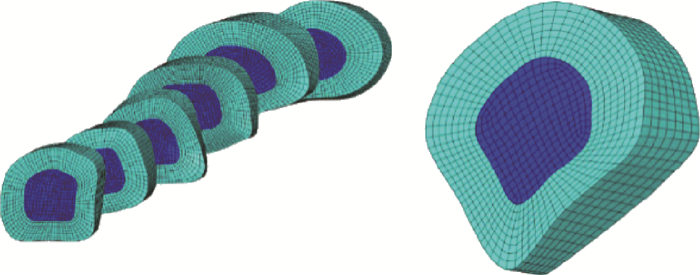Analysis and prediction of neck injury of pilots during carrier aircraft arrest deck-landing
-
摘要:
针对舰载机飞行员在阻拦着舰过程中因受到较大的阻拦载荷而导致颈部疼痛发病率较高问题,采用有限元方法开展了持续过载条件下飞行员颈部的生物力学响应研究。基于CT扫描图像,运用Mimics对头部及C1-T1椎体进行三维重建,利用Geomagic Studio进行曲面构型,运用Hypermesh和ABAQUS建立有限元模型,并在ABAQUS中计算各椎体及软组织的应力应变情况,结合损伤评价判定准则——NIC和
N ij 对飞行员颈部损伤情况进行分析和预测。结果表明:有限元模型动力学响应与静态和动态实验结果基本吻合,验证了模型的准确性和建模方法的可行性;关节囊韧带拉伸较其他韧带更长,易造成拉伤或松弛,长期训练会造成韧带受损、椎间盘突出和颈椎失稳等疾病;C4-C5椎间盘的应力均值大于C5-C6椎间盘,因此,该部位更容易造成损伤,应强化保护;颈部危重及以上损伤的概率仅为6.07%,即造成椎骨和脊髓损伤的可能性很小。研究结果可为飞行员颈部保护装置、对抗措施和飞行训练方法的设计与改进提供理论支撑。Abstract:Aimed at the high incidence of neck pain caused by large blocking load in the process of arrest deck-landing the aircraft carrier, the biomechanical response of pilots under the condition of continuous overload is studied by the finite element method. Based on CT scanning images, Mimics was used to perform the 3D reconstruction of the head and C1-T1 vertebrae, and Geomagic Studio was used to form a curved surface. The finite element model was established by Hypermesh and ABAQUS, and the stress and strain of each vertebra and soft tissue were calculated in ABAQUS. Combined with damage assessment criteria NIC and
N ij , the neck injury of pilots was analyzed and predicted. The results show that the dynamic response of the finite element model is in agreement with the static and dynamic experimental results, and the accuracy of the model and the feasibility of the modeling method are verified. The tension of the articular capsule ligament is longer than the other ligaments, and it is easy to cause injury or relaxation. Long-term training will cause diseases such as ligament damage, intervertebral disc herniation and instability of cervical vertebra. The mean stress of C4-C5 intervertebral disc is greater than that of C5-C6 intervertebral disc. Therefore, it is easier to cause injury and should be strengthened. The probability of critical and above injuries in head and neck is only 6.07%, that is, the possibility of injury to vertebrae and spinal cord is very small. The research results can provide theoretical support for the design and improvement of neck protection devices, countermeasures and flight training methods for pilots.-
Key words:
- arrest deck-landing /
- finite element /
- continuous overload /
- head and neck /
- injury analysis
-
组织名称 弹性模量/MPa 泊松比 密度/(10-3kg·m-3) 单元类型 皮质骨 10000 0.3 2.0 Shell 松质骨 450 0.3 1.0 Solid 椎骨终板 1000 0.4 1.83 Shell 纤维环 3.4 0.4 1.2 Solid 髓核 1.0 0.49 1.1 Solid 前纵韧带 28.2 0.4 1.1 Truss 后纵韧带 23 0.4 1.1 Truss 黄韧带 3.5 0.4 1.1 Truss 关节囊韧带 5 0.4 1.1 Truss 棘上韧带 4.9 0.4 1.1 Truss 翼状韧带 5 0.4 1.1 Truss 寰椎横韧带 20 0.4 1.1 Truss 齿突尖韧带 20 0.4 1.1 Truss 寰枕前膜 20 0.4 1.1 Truss 寰枕后膜 20 0.4 1.1 Truss 材料参数 数值 密度ρ/(kg·m-3) 1.06 泊松比ν 0.495 弹性分量μi/MPa 0.011 48 弹性分量αi 12.32 黏性分量Gi 0.001, 0.575, 0.288, 0.137 黏性分量βi/s-1 73.4, 50.3, 42.7, 0.255 AIS等级 损伤描述 0 无损伤(no injury) 1 轻微伤(minor) 2 中度伤(moderate) 3 较重伤(serious) 4 严重伤(severe) 5 危重伤(critical) 6 最危重伤(maximum) 9 未知等级(unknown) 表 4 预测各级损伤发生的概率
Table 4. Probability prediction of injury at all levels
损伤等级 概率/% AIS≥2 27.37 AIS≥3 18.99 AIS≥4 16.59 AIS≥5 6.07 -
[1] 郑峰婴.舰载机着舰引导技术研究[D].南京: 南京航空航天大学, 2007. http://cdmd.cnki.com.cn/Article/CDMD-10287-2007194405.htmZHENG F Y.Research on carrier-based carrier navigation technology[D].Nanjing: Nanjing University of Aeronautics and Astronautics, 2007(in Chinese). http://cdmd.cnki.com.cn/Article/CDMD-10287-2007194405.htm [2] 张选斌, 唐勇, 岳洪梅.±Gx加速度对航母舰载机飞行员的影响及防护对策[J].人民军医, 2013, 56(10):1124-1125. http://www.wanfangdata.com.cn/details/detail.do?_type=perio&id=rmjy201310003ZHANG X B, TANG Y, YUE H M.The influence of ±Gx acceleration on the pilots of aircraft carriers and countermeasures[J].People's Military Surgeon, 2013, 56(10):1124-1125(in Chinese). http://www.wanfangdata.com.cn/details/detail.do?_type=perio&id=rmjy201310003 [3] 张建, 王庆敏, 李明皋, 等.外军航母舰载机飞行员职业特点分析[J].海军医学杂志, 2012, 33(2):144-145. doi: 10.3969/j.issn.1009-0754.2012.02.040ZHANG J, WANG Q M, LI M G, et al.Analysis of occupational characteristics of aircraft carrier pilots of foreign military carriers[J].Journal of Navy Medicine, 2012, 33(2):144-145(in Chinese). doi: 10.3969/j.issn.1009-0754.2012.02.040 [4] 张建国, 周蕊, 薛强.基于挥鞭样损伤研究的颈部有限元模型的建立及验证[J].中国生物医学工程学报, 2008, 27(3):389-392. doi: 10.3969/j.issn.0258-8021.2008.03.013ZHANG J G, ZHOU R, XUE Q.Establishment and verification of cervical finite element model based on whiplash injury research[J].Chinese Journal of Biomedical Engineering, 2008, 27(3):389-392(in Chinese). doi: 10.3969/j.issn.0258-8021.2008.03.013 [5] ZHANG Q H, TEO E C, TAN K W.Effect of muscles activation on head-neck complex under simulated ejection[J].Journal of Musculoskeletal Research, 2011, 40(Supl.2):155-165. doi: 10.1142/S0218957704001326?src=recsys [6] YOGANANDAN N, KUMARESAN S, PINTAR F A.Geometric and mechanical properties of human cervical spine ligaments[J].Journal of Biomechanical Engineering, 2000,122(6):623-629. doi: 10.1115/1.1322034 [7] DUAN Y, WANG H H, JIN A M, et al.Finite element analysis of posterior cervical fixation[J].Orthopaedics & Traumatology:Surgery & Research, 2015,101(1):23-29. http://d.old.wanfangdata.com.cn/Periodical/zhcs201804005 [8] CAI X, YU Y, LIU Z, et al.Three-dimensional finite element analysis of occipitocervical fixation using an anterior occiput-to-axis locking plate system:A pilot study[J].Spine Journal Official Journal of the North American Spine Society, 2014, 14(8):399-409. https://www.sciencedirect.com/science/article/pii/S1529943013014721#! [9] YANG K H, HU J, WHITE N A, et al.Development of numerical models for injury biomechanics research:A review of 50 years of publications in the stapp car crash conference[J].Stapp Car Crash Journal, 2006, 50:429-490. [10] LI F, LI H G, HU W, et al.Simulation of muscle activation with coupled nonlinear FE models[J].Journal of Mechanics in Medicine & Biology, 2016, 16(6):1-14. http://www.wanfangdata.com.cn/details/detail.do?_type=perio&id=6f8d9de0be6cae13b5d3adf447649e04 [11] RAJ P P.Intervertebral disc:Anatomy-physiology-pathophysiology-treatment[J].Pain Practice, 2008, 8(1):18-44. doi: 10.1111/ppr.2008.8.issue-1 [12] MEYER F, BOURDET N, DECK C, et al.Human neck finite element model development and validation against original experimental data[J].Stapp Car Crash Journal, 2004, 48:177-206. http://d.old.wanfangdata.com.cn/NSTLHY/NSTL_HYCC0211750322/ [13] PANJABI M M, JR BRAND R A, WHITE A A.Mechanical properties of the human thoracic spine as shown by three-dimensional load-displacement curves[J].Spine, 1976, 58(5):42-52. http://www.wanfangdata.com.cn/details/detail.do?_type=perio&id=WK_LWW2017052520735224 [14] EWING C L, THOMAS D J, LUSTICK L, et al.Dynamic response of human and primate head and neck to +Gy impact acceleration: DOT-HS-803-058[R].Washington, D.C.: TRID, 1978. [15] YOGANANDAN N, KUMARESAN S, PINTAR F A.Biomechanics of the cervical spine Part 2.Cervical spine soft tissue responses and biomechanical modeling[J].Clinical Biomechanics, 2001, 16(1):1-27. http://www.wanfangdata.com.cn/details/detail.do?_type=perio&id=95e9a25fe424db1a5070430bcbc2ab99 [16] LV K, ZHU Q, LI X.Modeling and simulation for arrested landing of carrier-based aircraft[C]//2011 IEEE International Conference on Mechatronics and Automation.Piscataway, NJ: IEEE Press, 2011: 1928-1933. [17] PARR M J C, MILLER M E, BRIDGES N R, et al.Evaluation of the Nij neck injury criteria with human response data for use in future research on helmet mounted display mass properties[J].Neuromodulation Technology at the Neural Interface, 2012, 56(1):2070-2074. doi: 10.1177/1071181312561439 [18] 刘映璇.高速后碰撞时人体上颈椎的有限元分析[D].太原: 太原理工大学, 2017. http://cdmd.cnki.com.cn/Article/CDMD-10112-1017832305.htmLIU Y X.Finite element analysis of the upper cervical vertebrae in high-speed post-collision[D].Taiyuan: Taiyuan University of Technology, 2017(in Chinese). http://cdmd.cnki.com.cn/Article/CDMD-10112-1017832305.htm [19] BOSTRÖM O, SVENSSON M Y, ALDMAN B, et al.A new neck injury criterion candidate-based on injury findings in the cervical spinal ganglia after experimental neck extension trauma[C]//International IRCOBI Conference on the Biomechanics of Impact, 1996: 882-887. [20] PANJABI M M, ITO S, IVANCIC P C, et al.Evaluation of the intervertebral neck injury criterion using simulated rear impacts[J].Journal of Biomechanics, 2005, 38(8):1694. doi: 10.1016/j.jbiomech.2004.07.015 [21] TANNOUS R, EPPINGER R, EMILY S, et al.Development of improved injury criteria for the assessment of advanced automotive restraint systems-Ⅱ[J].Dummies, 1998, 54(8):151-152. [22] SCHMITT K U, MUSER M H, WALZ F H, et al.Nkm-A proposal for a neck protection criterion for low-speed rear-end impacts[J].Traffic Injury Prevention, 2002, 3(2):117-126. doi: 10.1080/15389580212002 -







 下载:
下载:



















